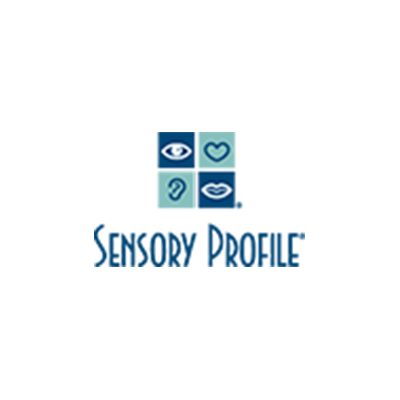Winnie Dunn, PhD, OTR, FAOTA
Overview:Determine how children process sensory information in everyday situations
Age Range:3-10 years
RTI Tiers:RTI Levels 1, 2 and 3
Completion Time:Untimed
Norms:Classification system based on normative information
Publication Date:1999
The next version of this product is now available. Read about the new Sensory Profile 2!
Your Scientifically-Based Choice
The Sensory Profile family of products includes the best-selling Sensory Profile, Infant/Toddler Sensory Profile, Adolescent/Adult Sensory Profile, and the Sensory Profile School Companion. The expansive age-range of Sensory Profile products allows you to confidently evaluate sensory-related difficulties in clients, from birth to geriatric. The Sensory Profile Supplement and Sensory Profile Select Scoring Assistants are now available.
Whatever the age of your clients — infant, child, adolescent, or adult — Sensory Profile products can help you:
- Understand the complexities of their sensory processing
- Gather critical sensory information related to home, school, and work
- Design strategies for managing daily life
Build evidence in you practice
These unique instruments offer a research-based, family-centered approach to sensory processing and provide case studies and guide you in interpretation and intervention planning. For more information about how these assessments work together click here.
For further information about the administration, scoring, or interpretation, please click on the appropriate link below:
- Adolescent/Adult Sensory Profile
- Infant/Toddler Sensory Profile
- Sensory Profile
- Sensory Profile School Companion
- Sensory Profile Supplement
Meet a Child’s Sensory Processing Needs
With Sensory Profile™, you can determine how well children ages 3 to 10 years process sensory information in everyday situations. You can also profile the sensory system’s effect on functional performance. The results of Sensory Profile, when considered with other evaluation data, will give you greater insight about the child for diagnostic and intervention planning.
Developed by Dr. Winnie Dunn, well known in the field of sensory integration, Sensory Profile will help you understand a child’s sensory processing patterns.
Sensory Profile Supplement
Winnie Dunn, Ph.D., OTR, FAOTA
The Sensory Profile Supplement offers the latest research available on sensory processing. This resource provides general information about sensory processing and problem solving strategies supported by clinical reasoning, along with expanded cut scores and quadrant cut scores. Use this supplement in conjunction with the current Sensory Profile to target effective intervention.
Structure
Items are grouped by sensory processing, modulation, and behavioral and emotional responses. The nine factor groupings characterize children by their responsiveness to sensory input including, Sensory seeking, Emotional reactive, Low endurance/tone, Oral sensory sensitivity, Inattention/distractibility, Poor registration, Sensory sensitivity, Sedentary, and Fine motor/perceptual.
Sample Study
The development of this evaluation tool was based on research on over 1,000 children, including children with disabilities, ADHD, and autism.
Features & Benefits
Link performance strengths and barriers with a child’s sensory processing patterns
The profile contributes to a comprehensive picture of a child’s performance. Combine it with other evaluation data to create a complete picture of the child’s status for diagnostic and intervention planning.
Caregivers complete the 125-question profile, reporting the frequency with which their child responds to various sensory experiences. Once the questionnaire is completed, use the Summary Score Sheet to obtain a profile of the child’s sensory responses. The Summary Score Sheet contains an area to record the child’s demographic information, a Factor Grid to help summarize the child’s scores into the nine factor groupings (i.e., Factor Summary), and a Section Summary to plot section raw score totals. The Short Sensory Profile is a 38-item caregiver questionnaire and score sheet designed for use in screening and research protocols. The items on the Sensory Profileare grouped into three major sections: sensory processing, modulation, and behavioral and emotional responses.
The Sensory Profile Caregiver Questionnaire, Summary Score Sheet, and Short Sensory Profilehave been translated into Spanish. Each item was translated into Spanish, then retranslated back into English, by two independent consultants to ensure that the Spanish translation retained the original intent of the Sensory Profile. The classification system and cut scores were maintained for the Spanish version based on the assumption that children’s sensory processing abilities are universal across cultures.
Areas of Assessment
Use the profile’s nine factor groupings to characterize children by their responsiveness to sensory input, sensory seeking, emotional reactive, low endurance/tone, oral sensory sensitivity, inattention/distractibility, poor registration, sensory sensitivity, sedentary, and fine motor/perceptual.
The manual presents information on administration, scoring, interpretation guidelines, development, and technical properties (reliability and validity).
Examining Sensory Quadrants in Autism (PDF – 141 KB)
Discover how a parent’s sensory ability can impact a child with Sensory Difficulties
Evaluate parents of a child or infant with sensory processing challenges with Adolescent/Adult Sensory Profile.
By profiling the parents for their sensory processing responses, you will gain valuable insights into the child’s interactions and help to build more family-centered intervention strategies.
See the benefits of having a parent of a child with sensory processing difficulties take the Adolescent/Adult Sensory Profile, by reading this real-world example, case study.
Sensory Profile Supplement
Winnie Dunn, Ph.D., OTR, FAOTA
The Sensory Profile Supplement offers the latest research available on sensory processing. This resource provides general information about sensory processing and problem solving strategies supported by clinical reasoning, along with expanded cut scores and quadrant cut scores. Use this supplement in conjunction with the current Sensory Profile to target effective intervention.
Questions
Frequently asked questions follow. Click on a question to see the response.
-
When should I use the Sensory Profile?
-
How will the Sensory Profile assist me in getting a child qualified for services in schools?
-
How does it meet IDEA ’97 mandates?
-
Is it appropriate to administer the Sensory Profile on a child with severe disabilities?





